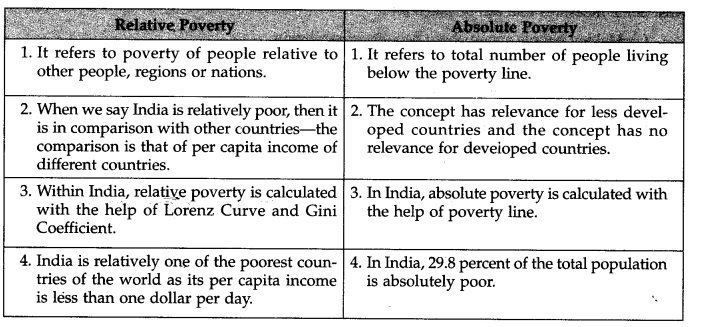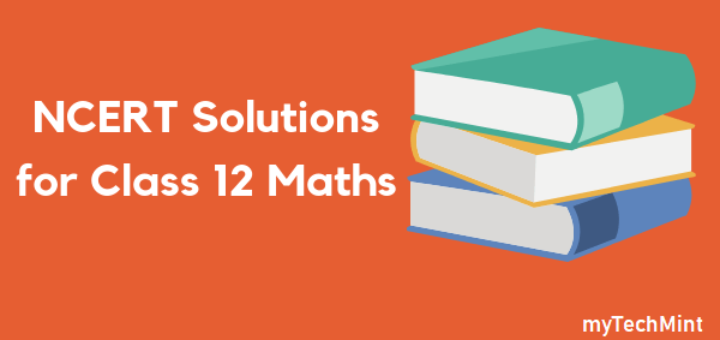NCERT Solutions for Class 11 Economics Chapter 4 – Poverty
Question 1. Define poverty.
Answer. Poverty in India has been defined as a situation in which an individual fails to earn income sufficient to buy him minimum means of subsistence.
Question 2. What is meant by ‘Food for Work’ programme?
Answer. National Food for Work Programme (NFWP). This programme was initially launched w.e.f. February 2001 for five months and was further extended. This programme aims at augmenting food security through wage employment in the drought affected rural areas in eight States, i.e., Gujarat, Chhattisgarh, Himachal Pradesh, Madhya Pradesh, Maharashtra, Orissa, Rajasthan and Uttaranchal. The centre makes available appropriate quantity of foodgrains free of cost to each of the drought affected States as an additionality under the programme. Wages by the State government can be paid partly in kind and partly in cash. The workers are paid the balance of wages in cash, such that they are assured of the notified minimum wages.
Question 3. State an example each of self-employment in rural and urban areas,
Answer. PMRY is a self-employment programme in rural areas.
SJSRY is a self-employment programme in urban areas.
Question 4. How can creation of income earning assets address the problem of poverty?
Answer. With the creation of income earning assets, people will have a way to earn their livelihood. It will help in removal of poverty.
Question 5. Briefly explain the three-dimensional attack on poverty adopted by the government.
Answer. A country is caught in a vicious trap once poverty is inbuilt in the system. The government has followed three-dimensional poverty removal programme. These dimensions are:
- The rate of economic growth should be raised. Economic growth can be helpful in removing poverty by the trickle down effect. It was felt that raised economic growth would benefit the underdeveloped region and the more backward sections of the society.
- Various beneficiary-oriented programmes need to be strengthened. For this, local institutions have to be involved in these programmes. The activities should be organised on a co-operative basis. Major training programmes should be taken up to improve the skills of potential workers.
- To provide minimum basic amenities. The provision of basic anenities should be made like water supply, sanitation, nutrition, etc. to the people.
Question 6. What programmes has the government adopted to help the elderly people and poor and destitute women?
Answer.
- National Social Assistance Programme (NSAP). NSAP was introduced on 15 August, 1995 as a 100 per cent Centrally Sponsored Scheme for social assistance to poor households affected by old age, death of primary bread earner and maternity care. The programme has three components, i.e., N ational Old Age Pension Scheme (NOAPS), National Family Benefit Scheme (NFBS) and National Maternity Benefit Scheme (NMBS).
- Annapurna. This scheme came into effect from April 1, 2000 as a 100 per cent Centrally Sponsored Scheme. It aims at providing food security to meet the requirement of those senior citizens who though eligible for pensions under the National Old Age Pension Scheme, are not getting the same. Foodgrains are provided to the beneficiaries at subsidised rates of Rs. 2 per kg of wheat and Rs. 3 per kg of rice. The scheme is operational in states and 5 union territories. More than 6.08 lakh families have been identified and the benefits of the scheme are passing on to them.
Question 7. Is there any relationship between unemployment and poverty? Explain.
Answer. Unemployment means lack of living. It leads to hunger, gloom, pessimism, indebtedness, etc. They all are signs of poverty.
Question 8. What is the difference between relative and absolute poverty?
Answer.
Question 9. Suppose you are from a poor family and you wish to get help from the government to set up a petty shop. Under which scheme will you apply for assistance and why?
Answer. The assistance can be given by Aajeevika. In this scheme one can get financial help in the form of bank loans. Other Programmes which can provide help are:
- REGP (Rural Employment Generation Programme)
- PMRY (Pradhan Mantri Rctegar Yojana).
Question 10. Illustrate the difference between rural and urban poverty. Is it correct to say that poverty has shifted from rural to urban areas? Use the trends in poverty ratio to support your answer.
Answer. In the rural areas, poor people are those who are landless agricultural labourers, small and mar¬ginal farmers. In the urban areas, poor people are those who are unemployed, underemployed or employed in low productivity occupations with very low wages.
Rural-Urban Break-up of Poverty Following pattern emerges:
- The decline in poverty was comparatively much steep in rural areas where the percentage
of people living below poverty line fell to 33.8 per cent (2009-10) from 41.8 per cent (2004-05). - In urban areas, percentage of people living below poverty line fell to 20.9 per cent (2009-10) from 25.7 per cent (2004-05).
- The number of people living below poverty line was estimated at 354.7 million in 2009-10.
Question 11. Explain the concept of relative poverty with the help of the population below poverty line in some states of India.
Answer. Relative Poverty refers to poverty in relative terms. It refers to poverty of people in comparison to other people, regions or nations. It indicates that a group or class of people belonging to the lower income groups is poorer when compared to those belonging to higher income groups. Among the major states, percentage of people living below poverty line was 37.9 per cent in
Assam, 23.0 per cent in Gujarat, 20.1 per cent in Haryana, 23.6 per cent in Karnataka, 36.7 per cent in Madhya Pradesh, 24.8 per cent in Rajasthan and 26.7 per cent in West Bengal in 2009-10.
Question 12. Suppose you are a resident of a village, suggest a few measures to tackle the problem of poverty.
Answer. Some measures that can be taken are:
- Making people aware about benefits of sanitation.
- Telling people about various programmes of the government.
- Helping people to take loan and get self employed.
- Keeping a control on growth rate of population.
- Helping people to start small scale and cottage industries which would generate employment.




